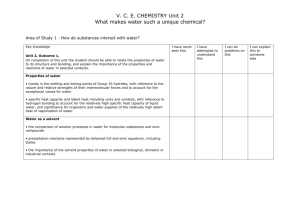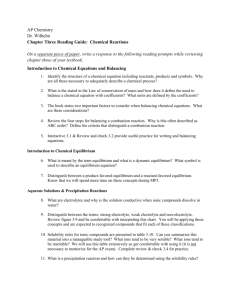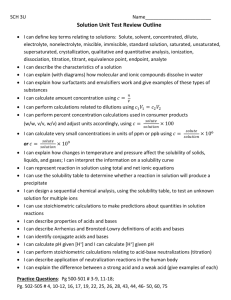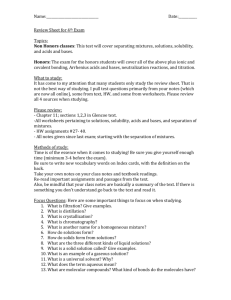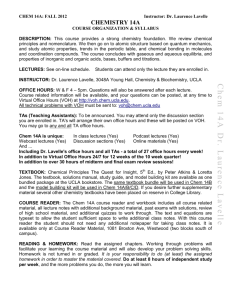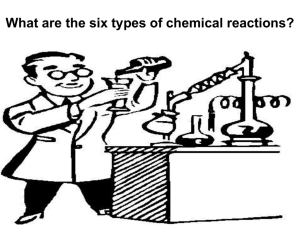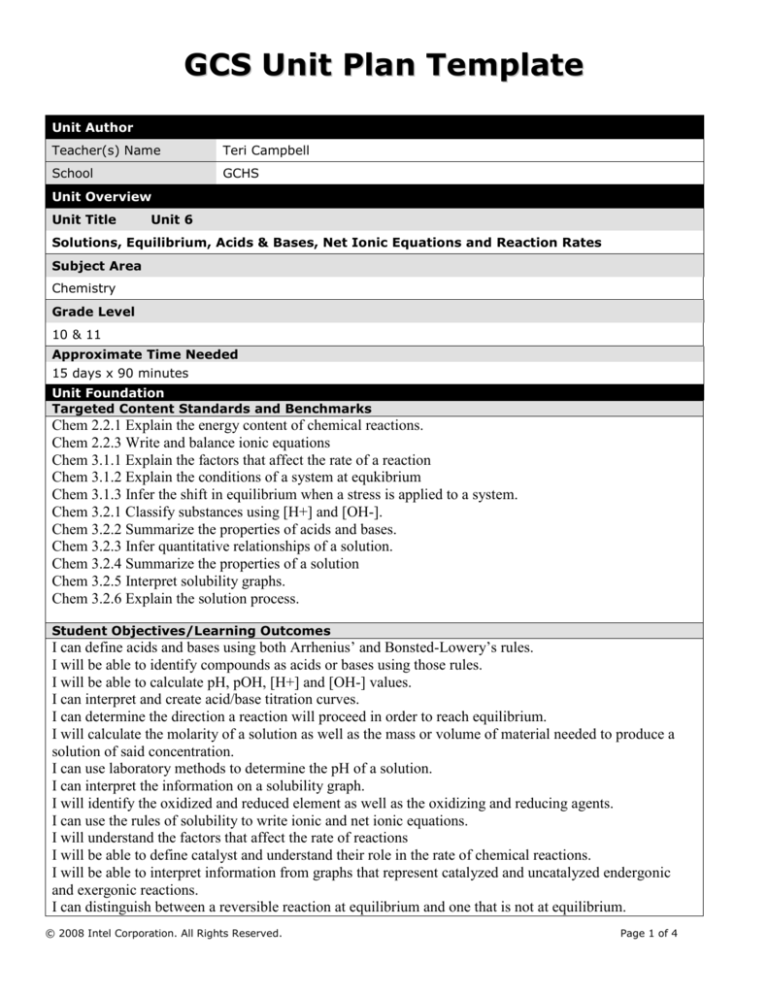
GCS Unit Plan Template
Unit Author
Teacher(s) Name
Teri Campbell
School
GCHS
Unit Overview
Unit Title
Unit 6
Solutions, Equilibrium, Acids & Bases, Net Ionic Equations and Reaction Rates
Subject Area
Chemistry
Grade Level
10 & 11
Approximate Time Needed
15 days x 90 minutes
Unit Foundation
Targeted Content Standards and Benchmarks
Chem 2.2.1 Explain the energy content of chemical reactions.
Chem 2.2.3 Write and balance ionic equations
Chem 3.1.1 Explain the factors that affect the rate of a reaction
Chem 3.1.2 Explain the conditions of a system at equkibrium
Chem 3.1.3 Infer the shift in equilibrium when a stress is applied to a system.
Chem 3.2.1 Classify substances using [H+] and [OH-].
Chem 3.2.2 Summarize the properties of acids and bases.
Chem 3.2.3 Infer quantitative relationships of a solution.
Chem 3.2.4 Summarize the properties of a solution
Chem 3.2.5 Interpret solubility graphs.
Chem 3.2.6 Explain the solution process.
Student Objectives/Learning Outcomes
I can define acids and bases using both Arrhenius’ and Bonsted-Lowery’s rules.
I will be able to identify compounds as acids or bases using those rules.
I will be able to calculate pH, pOH, [H+] and [OH-] values.
I can interpret and create acid/base titration curves.
I can determine the direction a reaction will proceed in order to reach equilibrium.
I will calculate the molarity of a solution as well as the mass or volume of material needed to produce a
solution of said concentration.
I can use laboratory methods to determine the pH of a solution.
I can interpret the information on a solubility graph.
I will identify the oxidized and reduced element as well as the oxidizing and reducing agents.
I can use the rules of solubility to write ionic and net ionic equations.
I will understand the factors that affect the rate of reactions
I will be able to define catalyst and understand their role in the rate of chemical reactions.
I will be able to interpret information from graphs that represent catalyzed and uncatalyzed endergonic
and exergonic reactions.
I can distinguish between a reversible reaction at equilibrium and one that is not at equilibrium.
© 2008 Intel Corporation. All Rights Reserved.
Page 1 of 4
I can determine the direction a reaction will proceed in order to reach equilibrium.
Cross-Curricular Connections
Math – Reading graphs and completing math equations
Curriculum-Framing Questions
Essential
Question
Unit
Questions
How do chemical properties of elements and compounds affect how they
interact with one another?
Which do you think is more harmful, an acid or a base? Why?
Why do you think gases are less soluble at higher temperatures?
Why have spectator ions if they do not participate in the chemical reaction?
Do you think Fritz Haber should have been awarded a Nobel Prize in Chemistry
for his contributions to the field? Explain your answer.
If you could create a catalyst to speed up any chemical reaction, which reaction
would it be and describe the shape of your catalyst.
What is oxidation and reduction?
Content
Questions
What is an oxidizing and reducing agent?
What is the definition of solubility and what are factors that affect solubility?
Assessment Summary
Above
Unit Details
Prerequisite Skills
Basic Math Skills, Writing, balancing and identifying types of chemical equations, graphical
interpretation skills
Instructional Procedures
Days 1-4 https://www.khanacademy.org/science/chemistry/states-ofmatter/v/solubility
Calculating molarity and mass of solute to make a solution
Reading Solubility graphs
Determining and comparing the keq and Q for reactions
Quiz on day 4
Days 5-8
http://www.youtube.com/watch?v=ANi709MYnWg
Arrhenius and Bronsted/Lowry definitions of acids and bases(indentifying acids, bases, conjugate
acids and conjugate bases)
Naming binary and ternary acids
Naming Arrhenius bases
Calculating pH, pOH, [H] and [OH]
Conducting a titration and completing the math
Quiz on day 5
Days 9 & 10
Using the Solubility Rules in the packet to write net ionic equations
Days 11-13 http://www.youtube.com/watch?v=-wvnX1f7yRY
© 2008 Intel Corporation. All Rights Reserved.
Page 2 of 4
Defining the terms associated with redox rxns : oxidation, reduction, oxidizing agent and reducing
agent.
Identifying redox reactions and writing simple half reactions
Day 14
Review for Unit Test
Day 15
Unit Test
Accommodations for Differentiated Instruction
Special Needs
Students
One on one assistance, student tutors, small group assignments
Gifted/Talented
Students
Writing complete half reactions
Materials and Resources Required For Unit
Technology – Hardware (Click boxes of all equipment needed)
X Interactive Technology
Computer(s)/iPads, etc.
Student Response
System/Clickers
Printer
Digital Camera
X Projection System
X DVD Player
Scanner
X Internet
Cell Phone
Video Camera
Video Conferencing Equip.
Document Camera
Other
X Television
Technology – Software (Click boxes of all software needed.)
Database/Spreadsheet
Image Processing
Web Page Development
Desktop Publishing
Internet Web Browser
Word Processing
E-mail
Multimedia
Other
X Web-Based Encyclopedia
Test book Merrill and Prentice Hall and worksheets associated with each
Printed Materials
Teacher made worksheets
Chemistry Reference Packet
Pipets, vinegar, sodium hydroxide, phenolphthalein
Supplies
© 2008 Intel Corporation. All Rights Reserved.
Page 3 of 4
Unit Plan Reflection
Describe any adaptations or “tweaks” to the resource or lesson plan that were needed:
What do you plan to do differently the next time you teach this unit?:
Due to the extended time required to complete previous units I only had 8 days to complete this unit in
order to allow for 4 days of review. Eight days is not enough time to complete this unit. I was not able to
allow honors students to write completed half reactions in the redox unit nor did I have time to complete a
redox lab. I must make sure I have 15 days to cover this unit is future semesters.
Page 4 of 4


